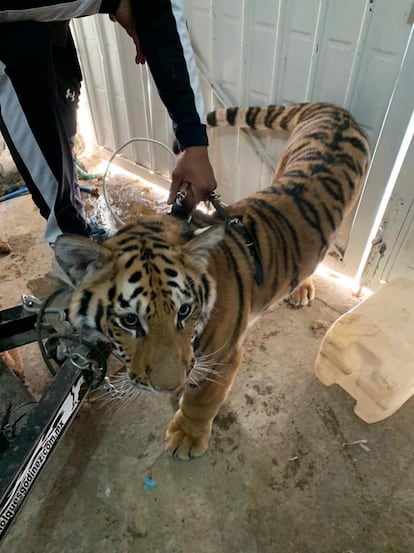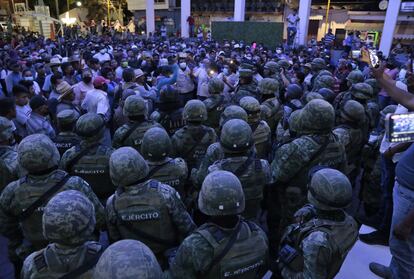The mystery behind a narc’s three lost tigers
Cross accusations and piles of paperwork are hiding the absence of the three big cats that were confiscated from a criminal organization in February in Guerrero, Mexico

Three tigers are lost in Mexico without a single clue as to their whereabouts, whether they’re alive or not, or if their heads are decorating the wall of some mansion in Ixtapa. The last evidence of their existence is a set of pictures showing them lying on the floor of a cage in Guerrero, on the verge of death, skinny like a twig. The photographs are from February. In Guerrero, people say they starved to death. In Mexico City, people say that when they went looking for them, there was not even a trace to be found: the cage was as clean as the skin of the mammoths that decorate the capital’s new airport.
They were not circus tigers; their owners were allegedly drug traffickers. Whether they were pets or extermination machines –if they are, rather: they are still alive until proven otherwise– is one of many question marks that surround the matter. Chipalcingo’s retired bishop told EL PAÍS a few weeks ago that this alleged criminal group wouldn’t use some poor felines to get rid of the bodies of their enemies. The group called Los Ardillos uses other methods like sulfuric acid, said the bishop, who’s an expert on the criminal activity in the region.
Mexico is a singular country. Circuses are forbidden from using animals in order to avoid unnecessary cruelty, but it’s not so hard for anyone, a drunkard, a criminal or someone with nothing better to do to acquire a tiger, a cougar or a cheetah for no particular reason. According to the Mexican Federal Agency for Environmental Protection, officials have seized 35 big cats since 2018, most of them in the capital. That makes Mexico City not only the great urban sprawl of North America but also the metropolis of extreme extravagance. In other words: on any given Sunday, it is possible to see residents walking with a tiger in a downtown neighborhood, at a massive Rosalía concert, or at a Formula One Grand Prix.

A bureaucratic paradise, Mexico cannot even find an explanation for the absence of the three tigers. It’s also not certain whether someone is looking for them. Complaints have been filed, there are open inquiries, and proceedings have been carried out, but everything ends up in a funnel made of paperwork and cryptic words. At the rate that the news cycle moves, three tigers lost in February can’t compete against local and foreign tragedies for more than a couple of days. This is why the authorities’ attitude towards the matter is intriguing, an apparent interest that is as appealing as it is confusing.
Those who are trying their best are the Federal Agency for Environmental Protection, PROFEPA in its Spanish acronym, who have at least reported the situation to the Attorney General’s Office, calling it a crime against biodiversity. PROFEPA is upset because the Guerrero Prosecutor’s Office has pinned the blame on them and they don’t agree. Everything happened in 10 days of which practically nothing is known, but everyone knows exactly who to demand answers from.
Making them available
On February 15, the Guerrero Prosecutor’s Office, the Army, and the National Guard launched an operation in the small town of Quechultenango, Guerrero, four hours away from the capital. Home of Los Ardillos, a combination of political leaders, entrepreneurs and criminals, the municipality seems to be the dystopian version of the village of indomitable Gaulish warriors in the Asterix comic books. When the “Romans” arrived, hundreds of residents reacted by taking to the streets with banners, demanding the departure of the authorities, pointing out abuses and robberies. The tragic history of the police and military in Mexico makes any accusation plausible, but in this case, it seemed more like a choreography.
Soldiers and police from the Prosecutor’s Office had time, however, to raid several houses belonging to the criminal group. In one of them, they found “28 kilos of green grass,” weapons, cartridges, several vehicles, and… the tigers. Outside, the atmosphere was tense. The scene was a sight to behold: a handful of soldiers and prosecutors were locked up with three tigers in a house, while the people outside organized themselves so as to not let them go, demanding freedom. There was no way for the military and prosecutors to get the animals out of there, unless PROFEPA personnel were to show up, as the agency explained in the responses to an inquiry by EL PAÍS.
The tigers stayed in the cages and the neighbors kept the military and prosecutors inside the town, blocking the entry and exit routes. Officials and residents negotiated for hours and ended up drafting a document in which all parties stipulated that municipal police officers will from now on join the soldiers who patrol the area. The Ardillos didn’t publicly comment on the matter, but the deal didn’t seem to hurt them.

There is no mention of the tigers in the documents. Two days later, the Guerrero Prosecutor’s Office reported in a statement that the animals had been “made available to the competent authority,” in other words PROFEPA. In its responses to this newspaper’s inquiries, the agency denies it and points out that “actions were lacking in addition to a document to transfer legal and material responsibility from one institution to another.” That is, no matter what the Guerrero Prosecutor’s Office says, they were never formally in charge of the animals.
When asked about the specific meaning of the phrase “made available” and the practical applications in the case of the tigers, a spokesman for the Guerrero Prosecutor’s Office pointed out a few days ago that “making available means making available,” and did not go into more details. “As soon as I have relevant information on the subject, I will let you know, we’ll be in touch,” he settled.
PROFEPA explains that, in the days after the failed rescue, its workers began to plan a proper operation. They found a shelter in Tezontepec, Hidalgo, with a nice name: The Jaguar Cabins. “In addition, cages, vehicles, and medical equipment were prepared for their transfer, and veterinarians, specialists, and inspectors were appointed,” the agency indicates. On February 26, the team was sent down for the animals. Personnel from PROFEPA and the Guerrero Prosecutor’s Office went to Quechultenango to take charge of the tigers. The shock came when they arrived and the cage was empty and clean.
No news on the subject surfaced for several days, until March 4, when the photos of the dying beasts, lying on the floor of the same cage, emerged. Then began the short-lived and contained media war between PROFEPA and the state prosecutor’s office over accountability and the scope of their mutual responsibilities. Between March 4 and 6, several media outlets reported on the death of the animals, citing the testimony of residents of Quechultenango. The newspaper Reforma quoted a state government official saying that “what could have happened is that the owners of those tigers came back and took them away.”
No one has heard from the missing tigers again. There are currently three open investigations on the matter. Judging by the data on the very low effectiveness of prosecutors in Mexico, and the workload of all the agencies involved, the possibility that one day something will be known about the felines is practically zero.
Tu suscripción se está usando en otro dispositivo
¿Quieres añadir otro usuario a tu suscripción?
Si continúas leyendo en este dispositivo, no se podrá leer en el otro.
FlechaTu suscripción se está usando en otro dispositivo y solo puedes acceder a EL PAÍS desde un dispositivo a la vez.
Si quieres compartir tu cuenta, cambia tu suscripción a la modalidad Premium, así podrás añadir otro usuario. Cada uno accederá con su propia cuenta de email, lo que os permitirá personalizar vuestra experiencia en EL PAÍS.
¿Tienes una suscripción de empresa? Accede aquí para contratar más cuentas.
En el caso de no saber quién está usando tu cuenta, te recomendamos cambiar tu contraseña aquí.
Si decides continuar compartiendo tu cuenta, este mensaje se mostrará en tu dispositivo y en el de la otra persona que está usando tu cuenta de forma indefinida, afectando a tu experiencia de lectura. Puedes consultar aquí los términos y condiciones de la suscripción digital.
More information
Últimas noticias
Most viewed
- Reinhard Genzel, Nobel laureate in physics: ‘One-minute videos will never give you the truth’
- Oona Chaplin: ‘I told James Cameron that I was living in a treehouse and starting a permaculture project with a friend’
- Pablo Escobar’s hippos: A serious environmental problem, 40 years on
- Why we lost the habit of sleeping in two segments and how that changed our sense of time
- Chevy Chase, the beloved comedian who was a monster off camera: ‘Not everyone hated him, just the people who’ve worked with him’











































